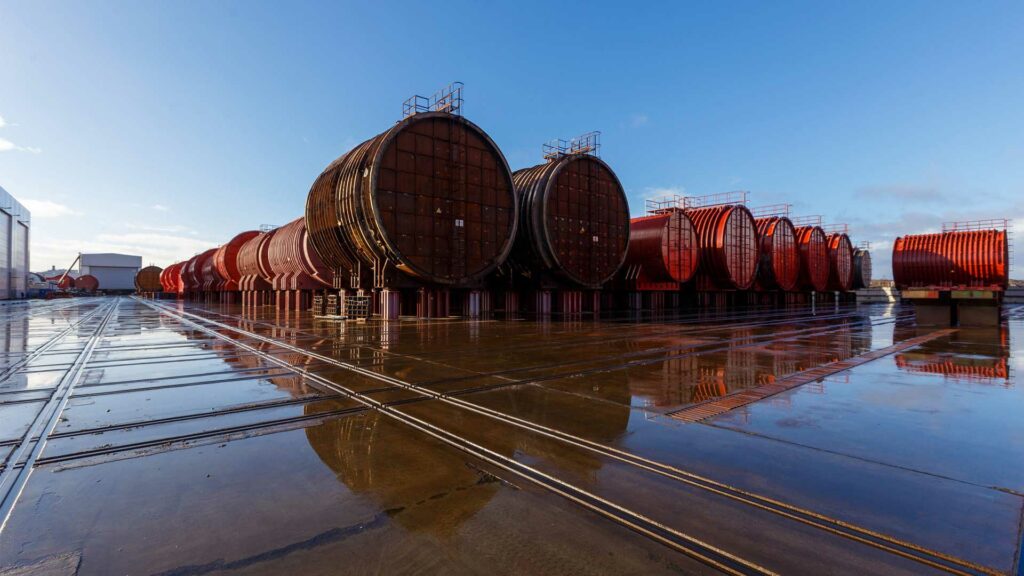AML3D and Deakin University Boron 3D Metal Printing
AML3D and Deakin University’s Institute for Frontier Materials (IFM) announces a series of collaborative feasibility projects exploring Boron 3D Metal Printing using Boron Nitride Nanotubes (BNNTs) in Wire Additive Manufacturing. The new composite could revolutionize Wire Additive Manufacturing (WAM) by enjoying far-reaching commercial industry implications for applications in 3D metal printing globally.
Boron 3D Metal Printing Aerospace
Research into Wire Additives and 3D Metal Printing
Based on preliminary research, it is possible that the targeted BNNT – Aluminium composite could have revolutionary properties. It would open up new industries and production opportunities for AML’s patented WAM technology.
This new project demonstrates a deeper partnership between AML3D Company and Deakin University and strengthens their technological and competitive advantages.
AML3D partners with Deakin University on Boron Nitride Nanotubes
AML3D Limited (ASX: AL3) announced a series of new proof-of-concept projects with Deakin University, which explore the incorporation of Boron Nitride Nanotubes technology (BNNTs). It will revolutionize AML3D’s WAM technology. Two further feasibility studies have been confirmed and will be underway immediately. They will examine two new methods for incorporating BNNTs in aluminum in the context of Wire Additive Manufacturing, with a view towards rapid commercialization.
AML3D’s Managing Director, Mr. Andrew Sales, commented on the partnership with Deakin University:
“The recent success of our current and ongoing high strength alloy developments for our patented WAM process has identified a further significant commercial opportunity for AML3D by incorporating BNNT into our wire feedstock. I’m extremely encouraged by this new development and hence why we are commencing another two projects separately from our current program. Successful development of these particular alloys can provide the company with significant upside. The opportunities for products and components have application across all our target sectors and has the potential to add another game-changing opportunity for us here at AML3D.”
Deakin University’s Senior Commercial Manager, Andrew Rau, commented:
“Deakin University is genuinely excited to be collaborating with AML3D to explore the feasibility of incorporating BNNTs with Aluminium, utilizing AML’s patented WAM technology. This research presents a unique opportunity to develop advanced materials with superior performance and develop a range of new applications for AML3D and their customers.”
The Board of AML3D has authorized the release of this announcement.
AML3D Limited is a publicly listed technology company that started in 2014. It uses new technologies to lead and pioneer metal additive manufacturing. AML3D Limited has patented a Wire Additive Manufacturing process (WAM), in which metal 3D prints large-scale commercial parts for Aerospace, Defence, Manufacturing, Mining, Oil & Gas, and Maritime. AML3D offers parts contract manufacturing at its Technology Centre in Adelaide. It is also the OEM for ARCEMY, an industrial 3D printing system that combines IIoT with Industry 4.0 to make manufacturers more competitive globally.
BNNT Science Formulation for Wire Additives
Boron Nitride Nanotubes
Boron Nitride nanotubes (BNNTs), the most robust and most advanced fiber globally, can significantly enhance the properties of WAM deposited alloys. Adding BNNTs and aluminum to other metals can result in stronger, lighter, and more radiation-resistant alloys. It dramatically expands the use of AML3D’s patented WAM technology within crucial industries such as space, transport, defense, marine, and aerospace.
Why Boron Nitride Nanotubes?
Boron nitride nanotubes (BNNTs) are mechanically and structurally identical to carbon nanotubes. BNNTs, however, have unique properties that are electrically insulating as well as transparent because of the polarized boron nitride bond.
These properties have kept BNNTs from being used for energy harvesting or electronic devices for over 25 years. Researchers have begun to show a variety of new applications for BNNTs over the last few years. These novel uses are based on properties that are not available in CNTs. Additionally, these applications also include osmotic energy harvesting using the charged outer surfaces of BNNTs.
They are single-electron room-temperature transistors using insulating BNTs as tunneling channels, high brightness fluorophores that can shine 1000 times brighter. It works better than regular dyes, transistors made from Tellurium atomic chain filled within BNNTs and transistors based on Tellurium-atomic chains.
The unique properties of BNNTs make them a promising material for many applications. However, current fabrication methods still face some challenges that need addressing.
BNNTs, which are still in their early stages of development, are now commercially available thanks to new fabrication techniques. The invention of the National Aeronautics and Space Administration Langley Research Center in 2014 made BNNTs commercially available for the first time. It has allowed for a broader range of applications.
Properties of BNNTs
Commercial BNNTs have the advantage of being nanoscale and having an aspect ratio similar to CNTs. They are not as valuable when CNTs’ functional properties must be avoided. BNNTs have better wetting, mechanical strength, and thermal resistance properties than CNTs. These properties are beneficial for many applications, including electronic, drug delivery, biomedical, aerospace, energy, energy, environmental, and other medical fields.
Composites made of BNNTs can enhance mechanical reinforcement and structural composites, thermal conductivity, high-temperature material processing, high temperatures applications (thermal barriers or fire resistance), etc. ), piezoelectric sensing, and energy harvesting. This wide range of applications for BNNT composites is essential for membrane science. There are currently a variety of studies that focus on ceramic or polymer membranes and the benefits of BNNTs.
Benefits/ Advantages of BNNTs over CNTs
Because of their high surface-to-volume ratio, nanotubes are gaining considerable attention as membrane materials. Many studies have been done on membranes using CNTs, silicon nanotubes (HNTs), halloysite nanotubes, and TiO nanotubes. CNT composites have demonstrated high performance in membrane applications, including permeability, selectivity, mechanical strength, and thermal properties.
BNNTs, however, have been recently introduced to membrane science. BNNTs have similar properties to CNTs to apply many of the same applications. BNNTs have better properties than CNTs in terms of wettability, water permeation, thermal conductivity, resistance and strength, and mechanical strength when used to make composite materials for membranes.
Transformative Products for New Markets
AML3D views these projects as an opportunity to create novel and transformative effects that have far-reaching implications in its WAM process and the 3D metal printing industry.
The company is encouraged by the existing research in the BNNT space that has identified the enhanced properties of nanomaterials. The new projects are a step toward widespread commercial adoption. BNNTs will revolutionize the advanced materials market with improved global production capacity and lower per-unit production costs. AML3D is eager to enhance this emerging technology using 3D metal printing to further the competitive advantage of its patented WAM technology.
It has previously worked with Deakin University on a variety of projects. AML3D is excited to start new ventures with this leading research institution.
Potential Applications in Aerospace
On November 2nd, 021, the company announced that it would produce a “specialized high-strength alloy part for a yet-to-be-named US aerospace company.” AML3D will supply a “high strength and corrosion-resistant alloy shape” using the above boron-based proprietary wire additive manufacturing (WAM) technology. This will be a bespoke solution. This will permit AML3D to play a strategic role in the rapidly-growing space exploration sector and open the door to further collaboration with other global aerospace organizations.





